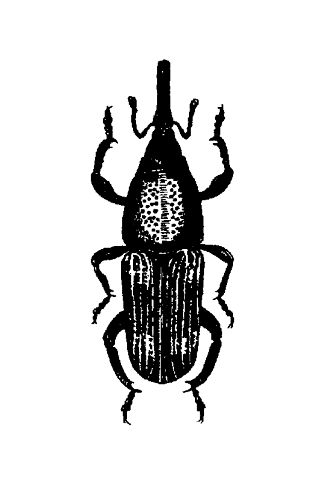Appearance
The rice weevil (Figure 1) is small, 1/10 inch (2 to 3 mm) and stout in appearance. It is very similar in appearance to the granary weevil. However, the rice weevil is reddish-brown to black in color with four light yellow or reddish spots on the corners of the elytra (the hard protective forewings). The snout is long (1 mm), almost 1/3 of the total length. The head with snout is as long as the prothorax or the elytra. The prothorax (the body region behind the head) is strongly pitted and the elytra have rows of pits within longitudinal grooves. The larva is legless and stays inside the hollowed grain kernel. It is fat with a cream-colored body and dark head capsule.

Habits
The rice weevil is one of the most serious stored grain pests worldwide. This pest of whole grain originated in India and has been spread worldwide by commerce. It now has a cosmopolitan distribution. It is a serious pest in the southern United States. The rice weevil is replaced by the granary weevil north of North Carolina and Tennessee. Both the adults and larvae feed on whole grains. They attack wheat, corn, oats, rye, barley, sorghum, buckwheat, dried beans, cashew nuts, wild bird seed, and cereal products, especially macaroni. The adult rice weevil can fly and is attracted to lights. When disturbed, adults pull in their legs, fall to the ground, and feign death. The larval rice weevil must complete its development inside a seed kernel or a man-made equivalent, like macaroni products. Larval rice weevils have been known to develop in hard caked flour. The adult female eats a cavity into a seed and then deposits a single egg in the cavity, sealing in the egg with secretions from her ovipositor. The larva develops within the seed, hollowing it out while feeding. The larva then pupates within the hollow husk of the grain kernel.
Biology
The adult female rice weevil lays an average of 4 eggs per day and may live for four to five months. The full life cycle may take only 26 to 32 days during hot summer months, but requires a much longer period during cooler weather. The eggs hatch in about 3 days. The larvae feed inside the grain kernel for an average of 18 days. The pupa is naked and the pupal stage lasts an average of 6 days. The new adult will remain in the seed for 3 to 4 days while it hardens and matures.
Control
The most important aspect of control is location of the source of the infestation. Place sticky traps around the room to locate the infestation, if not initially or easily located. Sticky traps with a higher density of rice weevils attached are probably closest to the infestation site. Common sources of infestations include decorative "Indian corn" saved from Thanksgiving, wild bird seed, dry plant arrangements that contain wheat or other seed heads, popcorn, beanbags or toys stuffed with grain, macaroni products, and seeds for sprouting. Infested materials should be destroyed or disposed of. All life stages can be killed by extreme heat (120°F for one hour) or cold (0°F for a week). The best control measure is to store products likely to be infested in pest-proof containers of plastic, glass, or metal. Seeds and nuts can be stored long term by adding a 1 inch cube (16 ml) of dry ice (solid carbon dioxide) to a quart mason jar of seeds and sealing the lid. The carbon dioxide atmosphere discourages all stored product pests.
Infestations in non-food areas can be treated with space sprays or crack and crevice treatments with residual insecticides having rice weevils listed on the label. Infestations in large quantities of grain are controlled by fumigation.